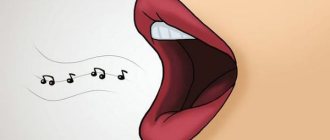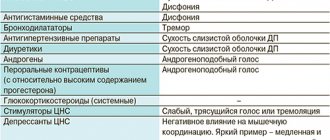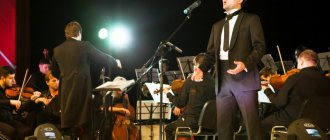“On Thursday the fourth at four and a quarter o’clock
the Ligurian traffic controller was regulating in Leguria,But 33 ships tacked, tacked, but never tacked..."
The above are typical exercises for improving speech and voice diction. They are great for both children and adults. From the article you will learn what articulation is and how to develop it. Examples of correct execution and tongue twisters will be given, as well as exercises for relaxing the tongue, jaw and articulatory gymnastics.
How to develop your singing voice at home to perfection
If you love to sing, but you and those around you are not happy with your vocals, don’t despair. Everyone has a voice, you just need to work on it: train your muscles to work as they should, and not as you want. Singing is a complex process in which both the speech apparatus and facial muscles are involved; Singing is influenced by both body position and the mood of the vocalist. It is no coincidence that in music schools they teach singing and work on sound delivery, timbre, vocal position and other technical aspects.
We conduct lessons ONLINE individually with a teacher. Fill out the form and the administrator will tell you everything.
Sign up
The reason for your, in your opinion, ugly singing can be anything: physical and psychological pressures, improper breathing, incorrect position of the larynx and soft palate, lack of direction of sound, etc. These are details that can be corrected by training, like singing through the nose, purity of intonation, and weak sound strength. Sometimes the reason for “I don’t have a voice” is an undeveloped ear for music or discoordination of hearing and voice. The result of one and the other is a failure to hit the notes, only undeveloped hearing is treated by working with solfeggio, and incoordination is treated with special vocal exercises. The point is that a person hears the notes, but cannot hit them, because does not control his singing apparatus.
To develop your voice at home, you need to go through the following steps:
- Learn to breathe correctly . Vocalists use diaphragmatic-lower costal breathing, i.e. control air flow using the muscles of the diaphragm. This gives a clean, smooth sound. If you breathe through your chest while singing, then the exhalation force will not be enough, and the person will switch to singing with ligaments. And this is a strangled sound and clamps.
- Place a support . This follows from the previous point. Support is the result of proper breathing, when while singing you feel a column of air inside. Singing on a support relieves tension and reveals your natural voice.
- Put sound production in order . When you learn to control the internal organs of the singing apparatus, you will be able to put it in the correct position, and your sound will take on a different character. Deeper, attacking, controlled. This point includes articulation training and exercises on the technical side of singing.
- Connect everything together . It sounds simple, but it requires regular training.
It is possible to develop a singing voice if you don’t have one. But it is more effective to do this under the guidance of a vocal teacher, because a person cannot hear himself or diagnose vocal problems. Even professional singers have teachers, but what to say about absolute beginners. The teacher will create an individual program based on the characteristics of your voice and protect you from injury to the ligaments.
What is articulation
Articulation is the coordinated work of all speech organs (oral cavity, lips, tongue, teeth, larynx, cheeks, jaw) in order to produce sound. And good diction (that is, clear pronunciation of sounds) depends precisely on the development of articulation.
Diction and articulation are one of the singer’s main tools, along with support and proper breathing. The more clearly the artist sings the words, the better the listener understands him, the greater the effect the singing itself produces. If a singer sings with good support, but clenches his jaw and chews his words, then he is unlikely to sound beautiful.
Examples of good articulation
Watch videos of popular artists. Some singers are simply textbook examples of how the speech apparatus works. So, you have a lot to learn from Steve Tyler, Linda Perry and Alla Pugacheva.
In all examples, the active work of all speech organs, including lips and tongue, is visible. It is noticeable how wide the mouth opens.
In singing, vowel sounds are usually lengthened, and consonants are shortened as much as possible. However, consonants should still sound as clear as possible.
Let me remind you that the correct position of the mouth in pop vocals is called the “Vocal mask”. VM is the position of the mouth in which sounds are produced as beautifully as possible. The point of using a vocal mask is to learn to speak and sing with a smile. The mask makes the lips elastic and opens up a large space for sound delivery.
Singing breathing as the basis of vocal work
Correct singing breathing is the basis for a vocalist’s success. It is not for nothing that the expressions “Singing is the art of exhalation” and “The art of singing is the art of breathing” are used. It is not surprising, because with improper breathing the voice sounds dull, there is no flexibility and mobility of the voice, and hoarseness appears after ten to fifteen minutes of singing. Correct singing breathing allows you to use the body's capabilities for beautiful singing: sing on a support, sing into resonators, control the strength and duration of exhalation. If you breathe incorrectly, you won’t hit a high note and won’t get a dense and even sound.
How to breathe correctly?
There are three types of breathing: clavicular, thoracic and abdominal. During clavicular breathing, a person's shoulders rise. It is superficial (the second name is upper breathing) - only the upper part of the lungs is involved in breathing. Upper breathing is not used when singing. Chest breathing (otherwise called costal breathing) causes the chest to expand when inhaling and contract when exhaling. Costal breathing is controlled by the intercostal muscles; the central part of the lungs is filled with air, which is not enough for singing. Abdominal (diaphragmatic) breathing is beneficial for health and correct for singing. This is how athletes, newborn babies, and opera singers breathe. Diaphragmatic breathing is given to us from birth; it is natural for humans. During abdominal breathing, while inhaling, the stomach protrudes, and the chest remains in a motionless position.
There is no doubt: to sing, learn to breathe! How does singing breathing occur? At the beginning of classes, the teacher explains how breathing works. Explains what sensations a person experiences when breathing correctly, and explains why to breathe diaphragmatically. Afterwards you will receive breathing training - special exercises to develop proper breathing, the ability to distribute air when exhaling and control inhalation. Establishing singing breathing is a long process: understanding how to breathe is not enough, it is important to consolidate the acquired skills in muscle memory.
Singing breathing as the basis of vocal work is perceived by all vocalists: adherents of academic vocals, pop singers, and populists. Singing breathing exercises develop muscles, which help stop sluggish breathing. Sluggish breathing is observed in beginners during a period when the muscles are unprepared for active work and the person inhales and exhales sluggishly. With sluggish breathing there is no support. Another problem that vocal students face is forced breathing. Having overdone it, a person noisily inhales excess air and exhales too forcefully. Singing breathing should be free and calm - this ensures evenness of sound.
Training the diaphragm ↑
Vocal exercises for breathing training should be performed daily, 10 times each. The simplest complex consists of 7 exercises.
- Choose a comfortable body position. Place one hand on your stomach, the other on the lower side of your chest. Take a deep breath. Make sure that the abdominal wall protrudes and the lower part of the chest expands (your hands will feel this well). Immediately exhale - smoothly, slowly. Feel your stomach and lower ribs return to their starting position.
- The position of the body and arms is the same. Inhale briefly through your nose, hold your breath for 2-4 seconds, and exhale smoothly and freely through your mouth. In this and all subsequent exercises, pay attention to the movements of the abdomen and lower chest.
- Inhale briefly through your mouth and, as you exhale, pronounce one of the vowel sounds in a drawn-out manner.
- Make several vowel sounds as you exhale.
- Count out loud as you exhale, trying to bring the count to 15. Make sure that the exhalation is free and smooth.
- Count backwards as you exhale (from 10 to 1).
- Read a proverb or tongue twister as you exhale.
What is included in the self-training of vocal artists
Learning vocals on your own from scratch, namely singing, is a traumatic activity. Vocal lessons are not only song analysis, the training course also includes breathing exercises, articulation exercises, tongue twisters for developing the diction of vocalists, and simple chants for vocalists. It is recommended to practice singing breathing and articulation for twenty to thirty minutes a day to train muscle memory for proper air supply and prepare the basis for the formation of correct sound production.
It is necessary for a beginning vocalist to train independently (in addition to classes with a teacher), otherwise, during the time between classes, the body will forget unstabilized skills. This way, singing growth will come sooner, and you will hear the results of vocal lessons.
How do vocal artists self-train?
We will describe the process of constructing an independent lesson, without examples of exercises, because For each beginner, the teacher selects suitable exercises for vocalists.
- Breathing exercises . Do a series of exercises selected according to the plan. Time for gymnastics is fifteen to twenty minutes. It is recommended to do it in the morning as a morning exercise or together with it, because... this saturates the blood with oxygen and invigorates.
- Articulation exercises . Smile, frown, stick out your tongue and twirl your lips - do as you would in class. This will activate the muscles involved in singing, develop and prepare them for singing.
- Tongue Twisters . Speak tongue twisters to develop clear diction. In vocals, especially pop, diction is important. Complicate the task: juggle during tongue twisters without losing the flow and pressure of pronunciation. Learn and take a step forward in vocals, because... you won’t have to think about pronouncing the text while singing.
- Choruses for vocalists . Together with your teacher, choose simple chants that you can do. Record the “minus” on a voice recorder and sing at home, controlling the sound production and breathing. The teacher will tell you within what range to sing so as not to break your voice. The chanting work of an artist vocalist consists of preparing the singing apparatus for singing and practicing sound production techniques, therefore more attention is paid to chanting in vocal lessons.
After reading what is included in the self-training of vocal artists, do not forget to consult with your teacher! Exercises for vocalists improve muscle tone and train muscle memory, but we advise you to exercise both physically and mentally. Listen to singers, analyze their vocals, discuss the singing style of a particular performer with a teacher. Read information about musical styles and the characteristics of vocals in them. Read about the structure of the singing apparatus and understand how sounds are produced; Find out what resonators are and why you shouldn’t strain your throat. When you learn, understand and feel this, you will easily complete the exercises proposed by the teacher, because you will understand his words.
Open lesson on the topic “Vocal speech and diction”
Larisa Shevchenko
Open lesson on the topic “Vocal speech and diction”
Open lesson on the Vocal program
on
the topic :
“ Vocal speech and diction ”
teacher of additional education Shevchenko Larisa Aleksandrovna.
Date: 01/12/2019
Student age: 10 years
Lesson duration: 45 minutes
Form of implementation: individual
Topic: “ Vocal speech and diction ”
Goal: Development of the vocalist’s articulatory apparatus within means
practicing the correct pronunciation of a word during performance
musical work.
Tasks:
Educational:
Teaching correct singing breathing, singing words on a yawn ,
singing consonants.
Educational:
-develop diction abilities and skills;
-develop imaginative thinking through musical expressiveness;
-develop the culture and manner of stage vocal performance : creative
self-expression, vocal individuality , muscular apparatus and fine
diction motor skills , the ability to convey a word to the listener ;
Educational:
-contribute to the formation of a culture of singing among students, as
aesthetic need, as part of their general artistic, and more broadly -
spiritual culture;
-contribute to the formation of interest in solo singing, concert
performances, creative self-expression when embodied in song
the feelings and thoughts that excite him.
Equipment and materials: piano, mirror, drawing
articulatory apparatus.
Organizing time
Teacher (P)
: Hello, Nadya! I am glad to see you.
1. Introductory part. Introduction to the topic .
P: At every lesson we learn to sing correctly and beautifully, we work on our voice, we try to learn how to master it. What is a voice?
Suggested student answer: The voice is our instrument.
P: to make our instrument sound beautiful, what needs to be done?
N: set it up, warm up the vocal apparatus, sing
P: right. The voice is a musical instrument. That's right
to tune means to sing correctly, but what do you think is the most important thing in singing?
H: correct breathing, clear intonation, correct sound production
P: that’s right, this is all very important in singing. And without what meaning and content
a vocal piece to the audience? Without what will our singing be meaningless?
N: without clear diction and words
P: Absolutely right!
2. Main stage. Explanation of the topic:
Diction – (lat.)
pronunciation.
Diction is understood as a clear , clear and distinct pronunciation of all sounds of the native language with their correct articulation with a clear and intelligible pronunciation of words and phrases . All this is ensured through the correct articulation of each sound, and, above all, the ability to open the mouth .
Our word addressed to the audience either in speech or in singing,
must be clear in pronunciation and expressive. Required
good diction , that is, clear, clear pronunciation (singing)
everyone
sounds and words of the text .
Today in class we will work on clear and correct
pronunciation of words when performing a song, over diction .
The topic of our lesson today. " Vocal word and diction "
.
Diction is a clear , clear, intelligible pronunciation (singing)
all sounds of the text. A person with good diction spends economically
air, it has no extraneous additional sounds.
P: What does it depend on?
N: (Student’s answer)
P: It depends on the activity of the speech apparatus. How are sounds and speech formed? What organs are involved in the formation of sounds? These include: cheeks, lips, tongue, jaws, soft and hard palate, pharynx, larynx, all this is called the articulatory apparatus.
The work of the organs of the articulatory apparatus is aimed at creating vowels
and consonants. It is necessary not to clamp the lower jaw, but to lower it freely, the tongue should be soft, free, the soft palate should be “on the yawn”
, the larynx is lowered.
In order to achieve good results, learn to speak and sing beautifully, you need to work on improving the articulatory apparatus, developing its technical capabilities. To do this, you need to do articulation gymnastics.
Articulation gymnastics
The first condition for the operation of the articulatory apparatus is naturalness and
activity. The simplest exercises will help us:
Articulation exercises
1. “A smile is a proboscis”
– teeth closed, smile with tension,
baring your teeth, then tensely stretch your lips forward like a tube.
2. "Proboscis"
– up, down, to the sides, circular, teeth are always closed.
3. "Spinner"
- rotate the tongue in a circle between the jaws and lips with
holding and pricking the tongue first in the right cheek, then in the left (jaw
motionless).
4. Movement of the jaw forward - backward, down to the maximum point, circular
5. Let’s energetically pronounce the following sounds while practicing:
muscles of the lips on consonants P - B, muscles of the tongue T - D, muscles of the larynx K-G.
6. "Ball"
- distillation of air from one cheek to the other, then under the upper
lip and under the lower one.
Very good for practicing tongue twisters.
Tongue twisters are used to warm up the articulatory apparatus and
activation of singing diction . We will read the tongue twisters first
slowly, gradually speeding up as you successfully improve.
We monitor the rhythm of pronunciation. Don't forget tempo and diction
(each tongue twister is repeated 4 times)
.
Recommendations: correct pronunciation is practiced in a tongue twister
consonants, work is also happening on the emancipation of speech
apparatus. If the text of the tongue twister sounds clear, then you can shift the tempo
pronunciation.
Three magpies were chattering on the hill.
Sasha walked along the highway and sucked on a dryer.
P.: Well done, Nadya! You did a good job with articulation
gymnastics.
Now let's start vocal exercises .
P. Nadya, what do you think, what are vocal exercises , maybe
Can you do without them?
L. You can’t... we have to warm up our ligaments...
P. It is imperative to warm up and sing, because you need a voice
tune.
P. I draw attention to the correct pronunciation and singing of sounds, accurate reproduction of intonation and rhythmic patterns.
Vocal exercises
1. The sound “M”
(mooing)
- we pull it
like a “rubber” one
, we direct it not
“inwards”
, but towards the front walls of the teeth.
The lips are softly closed. This exercise helps you feel the “breathing support”
2. “Lip trill”
- when performing this exercise, you must remember
about a smooth transition from lower to upper register. It is also necessary
follow the voice guidance, don’t forget about it. Chant for the sound "rrr"
3. We sing the vowels I, E, A, O, U. We monitor the evenness of the sound (connect
"pour"
one vowel into another, without pushing the sound, with pure intonation,
correctly forming (rounding)
vowels (we strengthen the skills of inhalation and exhalation,
aligning vowels on one note). that the melody needs to be sung.
The diaphragm and lips work. (Cantilena singing. Cantilena - continuously
pouring sound when the subsequent sound is a continuation
the previous one, as if “pouring out”
out of him).
4. On one sound - “Ma-me-mi-mo-mu, da-de-di-do-du, ra-re-ri-ro-ru”
.
The muscles of the lips and tongue are involved. When singing, you need to pay attention
clearly pronouncing consonant sounds, but at the same time ensuring that vowel sounds
were not shortened. You should also pay attention to the use
breathing - exhalation should not be strong.
5. Up the sounds of the triad to the syllables “la-le-lyu”
, down - incremental
movement from step 5 to 1 on the syllables “la-li-le-li-lyu”
- work exercise
tip of the tongue.
6. Within the third – “bra-bre-bri-bro-bru”
. It is necessary to monitor
active and clear pronunciation of consonants, but not shortening them
vowel sounds. Pay attention to breathing - do not push out the air along with the sound.
P.: Well done, Nadya! After we have prepared our vocal apparatus for
work, let's start working on our song. What should be the diction in
singing?
L. Legible, understandable.
P. How should you pronounce words in singing ?
L. Clearly, clearly.
P. What determines clear, clear pronunciation?
L. From the active work of articulatory organs (lips, tongue, soft palate,
lower jaw, pharynx)
Working on diction in a vocal work
P.: Nadya, now we will work on E. Grieg’s song “Children’s Song”
. Your task is to pronounce the text well in front of the mirror at a pace, articulating well, but at the same time you need to connect syllable by syllable so that the song does not turn into a conversation.
Working on the song:
- Saying the lyrics to the song in front of the mirror at a good pace
articulation.
- Performance of the work. Verse 1 and 2. We work according to phrases,
observing the correct pronunciation of consonants and vowels,
sound science, breathing. (We pronounce consonants clearly, briefly, but without
exaggeration. Vowels must be formed the same. Sound
don't lose your position. The student's attention should be directed to
concatenation of vowels with each other. Then the flow of consonants will be properly organized, which must be pronounced quickly and clearly)
— Next, we work on the work as a single whole.
Try to perform it completely (verse 1 and verse 2)
.
The final stage. Summarizing.
P.: Let’s summarize our lesson. Nadya, do you think you succeeded?
cope with the tasks in today's lesson ?
N. (student analyzes his work in class )
.
P. Today we paid a lot of attention to the development of the speech apparatus,
articulation, diction . We worked on consonant and vowel sounds in
exercises, tongue twisters, worked on breathing, sound science.
What is diction in general ?
G. - clear and competent pronunciation of sounds and words .
P. - Diction is a clear , clear, intelligible pronunciation (singing)
all sounds of the text, which depends on good articulation and
correct breathing.
Homework
1. Reading tongue twisters.
2. Do breathing exercises.
3. In front of the mirror, expressively pronounce the lyrics of the song with good
diction.










